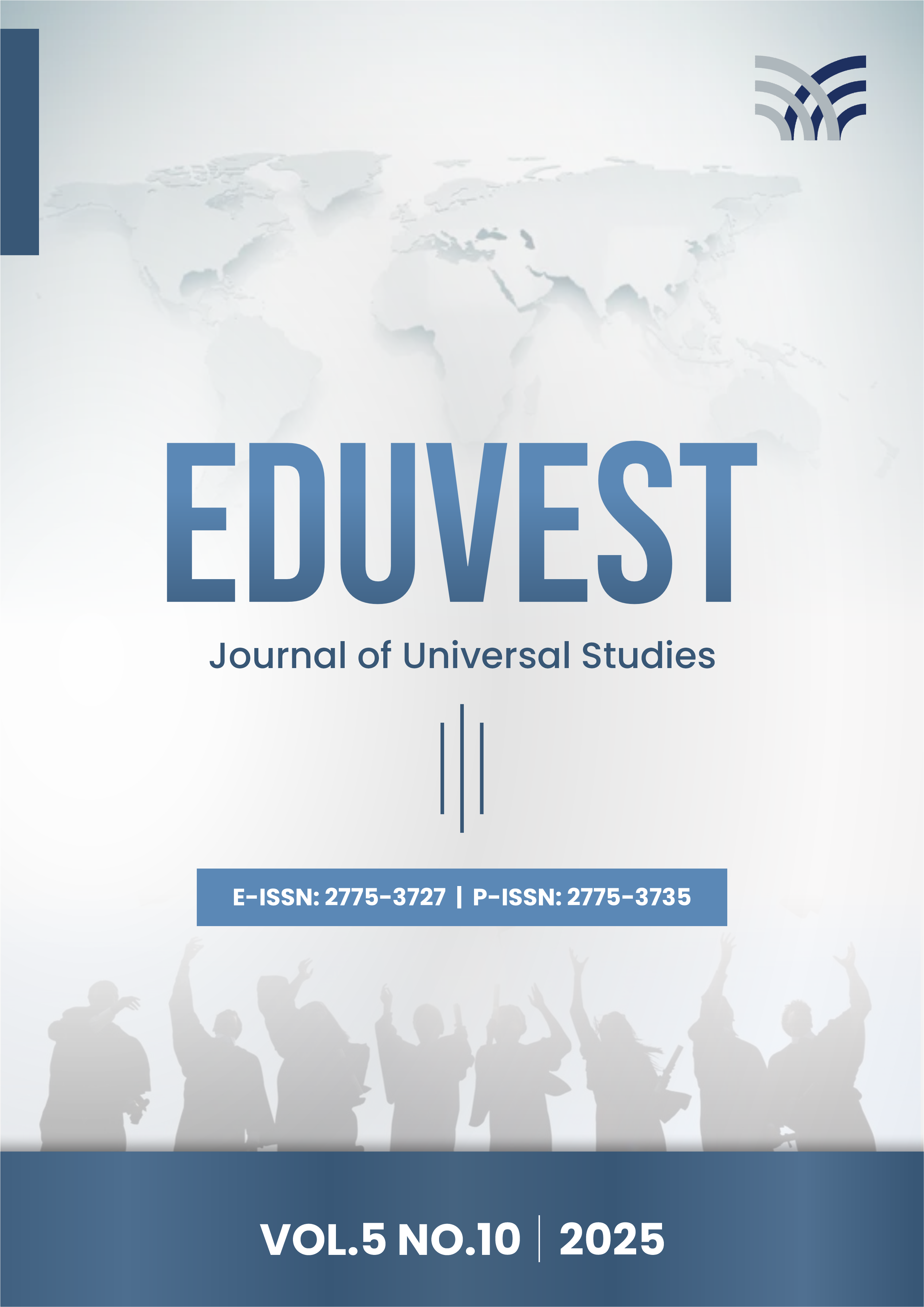Effect of Narrative Writing Intervention on Work Stress Among Employees with Consideration of Self-Disclosure
DOI:
https://doi.org/10.59188/eduvest.v5i10.52253Keywords:
Narrative writing, work stress, self-disclosure, experiment, interventionAbstract
Corporate acquisitions often trigger structural changes that heighten employee stress. Such changes can create anxiety and uncertainty regarding job positions and levels of control, particularly among employees who worked in the company prior to the acquisition. This study examines the Effect of Narrative Writing Intervention on Work Stress Among Employees with Consideration of Self-Disclosure. Using a quantitative experimental method, participants were divided into two groups: an experimental group that wrote about experiences and emotions related to work stress, and a control group that wrote about daily activities without expressing emotions or personal feelings. The instruments used were the 10-item Perceived Stress Scale (Cohen & Williamson, 1988) and the Modified 10-item Self-Disclosure Index (Miller et al., 2011). Findings indicate that self-disclosure enhances the effectiveness of narrative writing, as individuals with higher levels of self-disclosure were better able to process emotions and benefited more from the writing activity. A total of eight participants were evenly assigned to each group, based on their status before and after the company acquisition. Results showed that narrative writing functioned as a dynamic emotional process. Stress levels initially increased during the early intervention weeks but subsequently decreased significantly. Self-disclosure played a crucial role in this process, with participants reporting higher self-disclosure experiencing greater reductions in stress.
References
Augustine, A., & Eyssel, F. (2025). Motives and risks of self-disclosure to robots versus humans. Journal of Human-Robot Interaction, 14(1), Article 16, 44 pages. https://doi.org/10.1145/3700887
Breaugh, J. (2021). Too stressed to be engaged? The role of basic needs satisfaction in understanding work stress and public sector engagement. Public Personnel Management, 50(1), 84–108. https://doi.org/10.1177/0091026020912516
Cohen, S., & Williamson, G. (1988). Perceived stress in a probability sample of the United States. In S. Spacapan & S. Oskamp (Eds.), The social psychology of health (pp. 31–67). Sage Publications.
Cozby, P. C. (1973). Self-disclosure: A literature review. Psychological Bulletin, 79(2), 73–91. https://doi.org/10.1037/h0033950
Demirel, S., Roke, Y., Hoogendoorn, A. W., Hoefakker, J., Hoeberichts, K., & van Harten, P. N. (2024). Assessing the effectiveness of STAPP@Work, a self-management mobile app, in reducing work stress and preventing burnout: Single-case experimental design study. Journal of Medical Internet Research, 26, Article e48883. https://doi.org/10.2196/48883
Di Giuseppe, M., Nepa, G., Prout, T. A., Albertini, F., Marcelli, S., Orrù, G., & Conversano, C. (2021). Stress, burnout, and resilience among healthcare workers during the COVID-19 emergency: The role of defense mechanisms. International Journal of Environmental Research and Public Health, 18(10), 5258. https://doi.org/10.3390/ijerph18105258
Edú-Valsania, S., Laguía, A., & Moriano, J. A. (2022). Burnout: A review of theory and measurement. International Journal of Environmental Research and Public Health, 19(3), 1780. https://doi.org/10.3390/ijerph19031780
Guo, L. (2023). The delayed, durable effect of expressive writing on depression, anxiety, and stress: A meta-analytic review of studies with long-term follow-ups. British Journal of Clinical Psychology, 62(1), 3–27. https://doi.org/10.1111/bjc.12408
Hart, P. M., & Cooper, C. L. (2001). Occupational stress: Toward a more integrated framework. In Handbook of industrial, work and organizational psychology (Vol. 2, pp. 93–114). https://doi.org/10.4135/9781848608368
Harvey, J., & Boynton, K. (2021). Self-disclosure and psychological resilience: The mediating roles of self-esteem and self-compassion. Interpersona: An International Journal on Personal Relationships, 15(1), 90–104. https://doi.org/10.5964/ijpr.4533
Karlinda, I. D. B., Andhini, L. P. R., & Utami, N. M. S. N. (2022). Peranan self-disclosure terhadap stres mahasiswa saat kuliah daring di masa pandemi COVID-19. Jurnal Penelitian dan Pengukuran Psikologi, 11(2), 123–130. https://doi.org/10.21009/JPPP.112.06
Laureano-Morales, L., Saldaña-Santiago, N., Malave-Velez, N., Quiles-Aponte, J., Travieso-Perez, S., & others. (2024). Work stress and burnout among active correctional officers in Puerto Rico: A cross-sectional study. PLOS ONE, 19(10), e0304886. https://doi.org/10.1371/journal.pone.0304886
Lazarus, R. S., & Folkman, S. (1987). Transactional theory and research on emotions and coping. European Journal of Personality, 1(3), 141–169. https://doi.org/10.1002/per.2410010304
Lukenda, K., Sülzenbrück, S., & Sutter, C. (2024). Expressive writing as a practice against work stress: A literature review. Journal of Workplace Behavioral Health, 39(1), 106–137. https://doi.org/10.1080/15555240.2023.2240512
Lutz, N., Taeymans, J., Ballmer, C., Verhaeghe, N., Clarys, P., & Deliens, T. (2019). Cost-effectiveness and cost-benefit of worksite health promotion programs in Europe: A systematic review. European Journal of Public Health, 29(3), 540–546. https://doi.org/10.1093/eurpub/cky269
Miller, L. C., Berg, J. H., & Archer, R. L. (2011). Self-Disclosure Index [Database record]. APA PsycTests. https://doi.org/10.1037/t06121-000
Noguchi, Y., Kamide, H., & Tanaka, F. (2023). How should a social mediator robot convey messages about the self-disclosures of elderly people to recipients? International Journal of Social Robotics, 15(6), 1079–1099. https://doi.org/10.1007/s12369-023-01016-x
Park, K., Ko, Y., Han, S., & Ha, Y. (2023). The effects of a self-disclosure program using expressive writing on optimism, problem-focused coping, deliberate rumination, and posttraumatic growth of Korean firefighters with rescue-firefighting duties: A pilot study. Journal of Occupational Health Epidemiology, 12(2), 98–104. http://dx.doi.org/10.61186/johe.12.2.98
Pennebaker, J. W., & Beall, S. K. (1986). Confronting a traumatic event: Toward an understanding of inhibition and disease. Journal of Abnormal Psychology, 95(3), 274–281. https://doi.org/10.1037/0021-843X.95.3.274
Project Narrative. (n.d.). What is narrative theory? The Ohio State University. Retrieved November 23, 2024, from https://projectnarrative.osu.edu/about/what-is-narrative-theory
Saleem, S., Khadim, R., & Subhan, S. (2023). Mediating role of emotion disclosure between emotion regulation and apprehension in healthcare professionals during COVID-19. Khyber Medical University Journal, 15(3), 171–175. https://doi.org/10.35845/kmuj.2023.22017
Salvagioni, D. A. J., et al. (2017). Physical, psychological and occupational consequences of job burnout: A systematic review of prospective studies. PLOS ONE, 12(10), e0185781. https://doi.org/10.1371/journal.pone.0185781
Troester, J. (n.d.). The healing power of words. Jennifer Troester. Retrieved November 23, 2024, from https://www.jennifertroester.com/blog/healing-power-of-words
Wu, S., Pitafi, A. H., Pitafi, S., & Ren, M. (2021). Investigating the consequences of the socio-instrumental use of enterprise social media on employee work efficiency: A work-stress environment. Frontiers in Psychology, 12, Article 738118. https://doi.org/10.3389/fpsyg.2021.738118
Downloads
Published
How to Cite
Issue
Section
License
Copyright (c) 2025 Rizqa Fithra Ramadhani, Rita Markus Idulfilastri, Ninawati Ninawati

This work is licensed under a Creative Commons Attribution-ShareAlike 4.0 International License.











